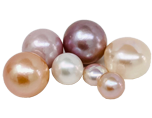Our Pearls
AKOYA
The Classic Pearl choice. Typically very round in shape, white, with deep, beautiful luster. Overtones include rose, silver and cream. Their sizes range from 2mm to 10mm with an average size of 7mm. Akoya pearls are favored by retailers and consumers alike for their elegance and high-quality properties. They are usually the gem of choice for many brides as they walk down the aisle. These are also appropriate pearls for young girls celebrating some milestone in their lives.
AKOYA HANADAMA
Hanadama pearls are certified top-of-the-range Akoyas. They are sold in strands and have been examined by the Pearl Science Laboratory of Japan as having very strong luster, a minimum nacre thickness of 0.8mm, a near flawless surface, spherically round shapes, and a visible orient (a rainbow-like soft bubble effect on the surface of the pearls). A numbered Certificate of Pearl Identification & Grading accompanies each strand.
GOLDEN & WHITE SOUTH SEA PEARL
The ultimate statement of luxury and glamour. South Sea Pearls are considered the rarest of all pearl types. This is due to their large size (average is 12mm), the limited culturing environment and the extended growth period needed to produce these pearls. Colors range from optic white to deep golden hues. They are often set in high-value fine jewelry, sometimes accompanied with diamonds, giving the wearer a radiant, luxurious glow.
TAHITIAN
These pearls are among the most popular pearls in the marketplace today. They may be dubbed as “black pearls”, but it is actually a misnomer since they come in a range of colors from white to black. Due to its variety of shapes and colors, they fit nicely in any jewelry setting. This versatility and mixture of color give it its value. If you want a dramatic touch to your jewelry, these exquisite gems are the way to go.
FRESHWATER
The most common and least expensive type of pearl. Freshwater pearls differ from other cultured varieties in that majority of them are non-bead nucleated. However, new trends in freshwater culturing are emerging wherein several nuclei are now being implanted within the soft inner tissues of a mussel. You can find freshwater pearls as small as a single millimeter in diameter to as large as 20mm+. Produced in every natural color and in a myriad of shapes, they add a basic charming appeal to jewelry.
KESHI
Although not one of the major pearl types, Keshi pearls are shape variations generally falling under the baroque classification. Found in all pearl varieties, they are all-nacre due to an unintentional glitch in the culturing process. Keshi are not found in large quantities making them valuable and in high demand. The free-form shapes of these pearls allow designers to create beautiful, unique, non-traditional jewelry styles.







